Ocean
- The Ocean Relief Features are quite different from the continental features because the Oceanic crust is less than 60-70- million years old whereas continental features are of Proterozoic age (Over 1 Billion years old).
- While there is only one global ocean, the vast body of water that covers 71 percent of the Earth is geographically divided into distinct named regions. The boundaries between these regions have evolved over time for a variety of historical, cultural, geographical, and scientific reasons.
- Historically, there are four named oceans: the Atlantic, Pacific, Indian, and Arctic. However, a new ocean has now been recognized as the Southern (Antarctic) ocean as the fifth ocean. The Pacific, Atlantic, and Indian are known as the three major oceans.
- They are the source of food– fish, mammals, reptiles, salt, and other marine foodstuffs.
- The tides can be harnessed to provide power.
- Oceanography is the branch of science that deals with the physical and biological properties and phenomena of the sea.
- Earlier echo-sounding techniques were used, now radar soundings and electrical Echo devices are used to find the precise depths of ocean floors and map the relief of oceans.
Ocean Relief Features
- The oceans, unlike the continents, merge so naturally into one another that it is hard to demarcate them.
- The geographers have divided the oceanic part of the earth into five oceans, namely the Pacific, the Atlantic, the Indian, Southern, and the Arctic.
- The various seas, bays, gulfs, and other inlets are parts of these four large oceans.
- A major portion of the ocean floor is found between 3-6 km below the sea level.
- The floors of the oceans are rugged with the world’s largest mountain ranges, deepest trenches, and the largest plains. These features are formed, like those of the continents, by the factors of tectonic, volcanic, and depositional processes.

Major Ocean Relief Features
The ocean floors can be divided into four major divisions:
- the Continental Shelf
- the Continental Slope
- the Deep Sea Plain
- the Oceanic Deeps
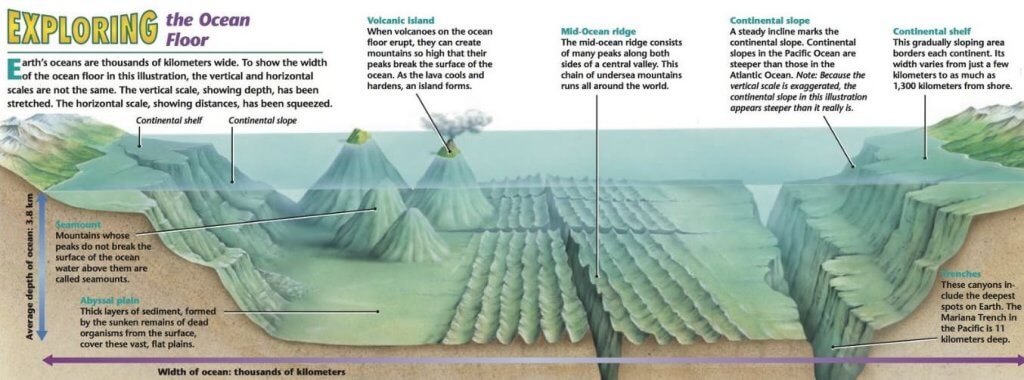
Continental Shelf
- Continental Shelf is the gently sloping seaward extension of continental plate.
- These extended margins of each continent are occupied by relatively shallow seas and gulfs.
- Continental Shelf of all oceans together cover 7.5% of the total area of the oceans.
- Gradient of continental is of 1° or even less.
- The shelf typically ends at a very steep slope, called the shelf break.
- The continental shelves are covered with variable thicknesses of sediments brought down by rivers, glaciers etc..
- Massive sedimentary deposits received over a long time by the continental shelves, become the source of fossil fuels [Petroleum].
- Examples: Continental Shelf of South-East Asia, Great Banks around Newfoundland, Submerged region between Australia and New Guinea.
- The shelf is formed mainly due to
- submergence of a part of a continent
- relative rise in sea level
- Sedimentary deposits brought down by rivers
- There are various types of shelves based on different sediments of terrestrial origin —
- glaciated shelf (Surrounding Greenland),
- coral reef shelf (Queensland, Australia),
- shelf of a large river (Around Nile Delta),
- shelf with dendritic valleys (At the Mouth of Hudson River)
- shelf along young mountain ranges (Shelves between Hawaiian Islands).
Continental Slope
- A continental slope is the slope between the outer edge of the continental shelf and the deep ocean floor.
- The continental slope is cut by submarine canyons in many locations.
- The continental slope marks the seaward edge of the continental shelf.
- The gradient of the slope region varies between 2-5°.
- It extends between the depth of 180 to 3600 metres.
- In some places, for example, off the shore of Philippines, the continental slope extends to a great depth.
- Continental slopes, mainly due to their steepness and increasing distance from the land have very little deposits of sediments on them.
- Sea life is also far less here than on the shelf.
- Along the base of the continental slope is a deposit of sediments. This belt of sedimentary deposits form the continental rise.
- In some regions the rise is very narrow but in others it may extend up to 600 km in width.
Continental Rise
- The continental slope gradually loses its steepness with depth.
- When the slope reaches a level of between 0.5° and 1°, it is referred to as the continental rise.
- With increasing depth, the rise becomes virtually flat and merges with the abyssal plain.
Deep Sea Plain or Abyssal Plain
- Deep sea planes are gently sloping areas of the ocean basins.
- These are the flattest and smoothest regions of the world because of terrigenous [denoting marine sediment eroded from the land] and shallow water sediments that buries the irregular topography.
- It covers nearly 40% of the ocean floor.
- The depths vary between 3,000 and 6,000 m.
- These plains are covered with fine-grained sediments like clay and silt.
- It has extensive submarine plateaus, ridges, trenches, beams, and oceanic islands that rise above sea level in the midst of oceans.
- E.g. the Azores, Ascension Island
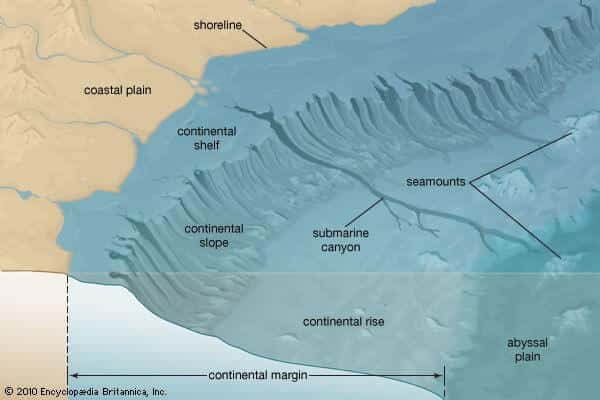
Oceanic Deeps or Trenches
- The trenches are relatively steep-sided, narrow basins (Depressions). These areas are the deepest parts of the oceans.
- They are of tectonic origin and are formed during ocean – ocean convergence and ocean-continent convergence.
- They are some 3-5 km deeper than the surrounding ocean floor.
- The trenches lie along the fringes of the deep-sea plain at the bases of continental slopes and along island arcs.
- The trenches run parallel to the bordering-fold mountains or the island chains.
- The trenches are very common in the Pacific Ocean and form an almost continuous ring along the western and eastern margins of the Pacific.
- The Mariana Trench off the Guam Islands in the Pacific Ocean is the deepest trench with, a depth of more than 11 kilometers.
- Other ocean deeps –
- Mindanao deep (35000 feet)
- Tonga trench (31000 feet)
- Japanese trench (28000 feet) (all 3 in the Pacific Ocean)
- They are associated with active volcanoes and strong earthquakes (Deep Focus Earthquakes like in Japan). This makes them very significant in the study of plate movements.
- As many as 57 deeps have been explored so far; of which 32 are in the Pacific Ocean; 19 in the Atlantic Ocean and 6 in the Indian Ocean.
Minor Ocean Relief Features
Apart from the above mentioned major relief features of the ocean floor, some minor but significant features predominate in different parts of the oceans.
- Ridges,
- Hills,
- Seamounts,
- Guyots,
- Trenches,
- Canyons,
- Fracture zones,
- Island arcs,
- Atolls,
- Coral reefs,
- Submerged volcanoes and
- Sea-scarps.

Mid-Oceanic Ridges
- A mid-ocean ridge is a seafloor mountain system formed by plate tectonics.
- It typically has a depth of about 2,600 meters and rises about 2,000 meters above the deepest portion of an ocean basin.
- This feature is where seafloor spreading takes place along a divergent plate boundary.
Seamount
- A seamount is an underwater mountain formed by volcanic activity.
- seamount does not reach the surface of the ocean.
- These can be 3,000-4,500 m tall.
- Emperor seamount, an extension of the Hawaiian Islands in the Pacific Ocean, is a good example.
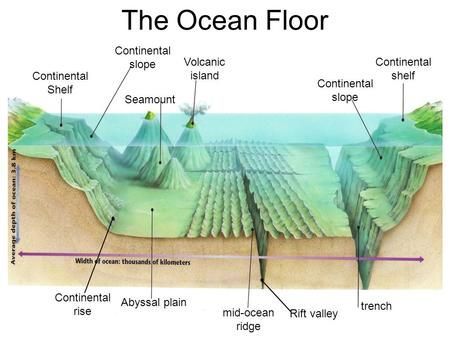
Submarine Canyons
- A submarine canyon is a steep-sided valley cut into the seabed of the continental slope, sometimes extending well onto the continental shelf, having nearly vertical walls, and occasionally having canyon wall heights of up to 5 km, from canyon floor to canyon rim, as with the Great Bahama Canyon.
- The Hudson Canyon is the best-known submarine canyon in the world.
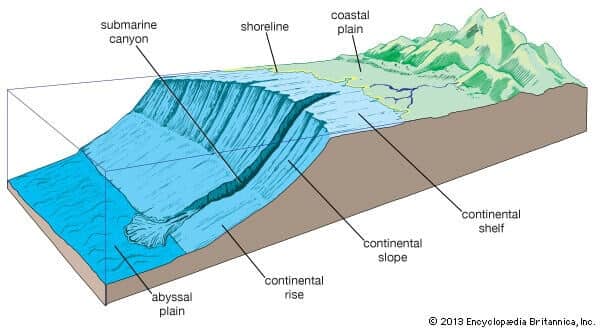
Guyots
- Guyot also known as a tablemount, is an isolated underwater volcanic mountain with a flat top more than 200 m below the surface of the sea.
- They show evidence of gradual subsidence through stages to become flat-topped submerged mountains.
- It is estimated that more than 10,000 seamounts and guyots exist in the Pacific Ocean alone.

Atoll
- An atoll, sometimes known as a coral atoll, is a ring-shaped coral reef, including a coral rim that encircles a lagoon partially or completely.
- There may be coral islands or cays on the rim. Atolls are located in warm tropical or subtropical oceans and seas where corals can grow.
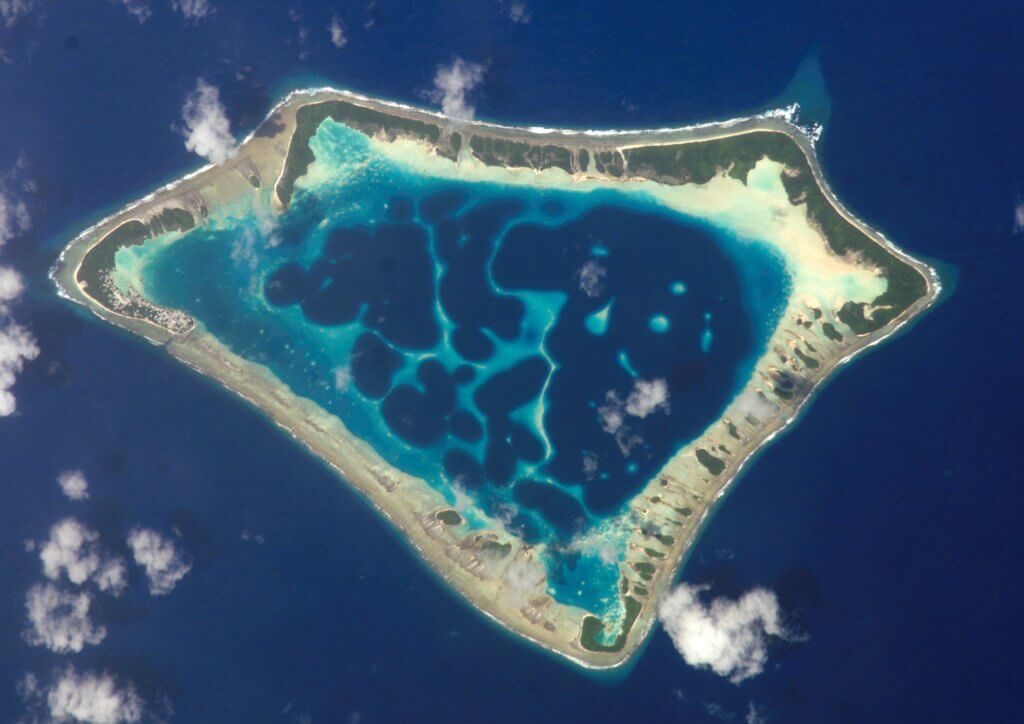
Bank
- These marine features are formed as’ a result of the erosional and depositional activity.
- A bank is a flat-topped elevation located in the continental margins.
- The depth of water here is shallow but enough for navigational purposes.
- The Dogger Bank in the North Sea and Grand Bank in the north-western Atlantic, Newfoundland are famous examples.
- The banks are sites of some of the most productive fisheries of the world.
Shoal
A shoal is a detached elevation with shallow depths. Since they project out of water with moderate heights, they are dangerous for navigation.
Reef
- A reef is a predominantly organic deposit made by living or dead organisms that form a mound or rocky elevation like a ridge.
- Coral reefs are a characteristic feature of the Pacific Ocean where they are associated with seamounts and guyots.
- The largest reef in the world is found off the Queensland coast of Australia. [We will study coral reefs in future posts]
- Since the reefs may extend above the surface, they are generally dangerous for navigation.
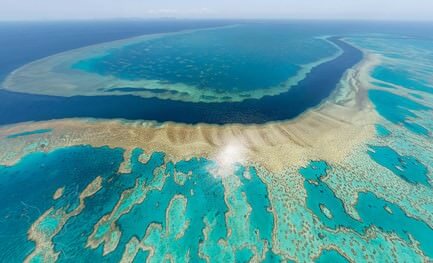
Significance of Study of Oceanic Relief
- Ocean relief controls the motion of sea-water.
- The oceanic movement in the form of currents, in turn, causes many variations in both oceans and in the atmosphere.
- The bottom relief of oceans also influences navigation and fishing.
Estuary vs Delta
The estuary is an area where saltwater of sea mixes with fresh water of rivers. It is formed by a tidal bore.
Delta is a low triangular area of alluvial deposits where a river divides before entering a larger body of water.
| BASIS FOR COMPARISON | ESTUARY | DELTA |
|---|---|---|
| Meaning | Estuary refers to the waterbody, along the coast, that are formed when fresh water of river meets salt water of ocean. | Delta connotes a landform that is formed by river-borne sediments deposited at the river mouth when it joins the sea. |
| Rivers | Narmada and Tapi form estuary. | Mahanadi, Godavari, Krishna, Cauvery, Ganga and Brahmaputra form delta. |
| Shape | Funnel | Triangular |
| Tide | High tides | Low tides |
| Region | Region near estuary are not fertile. | Delta are fertile lands. |
| Suitable for | Fishing activity | Agriculture activities |
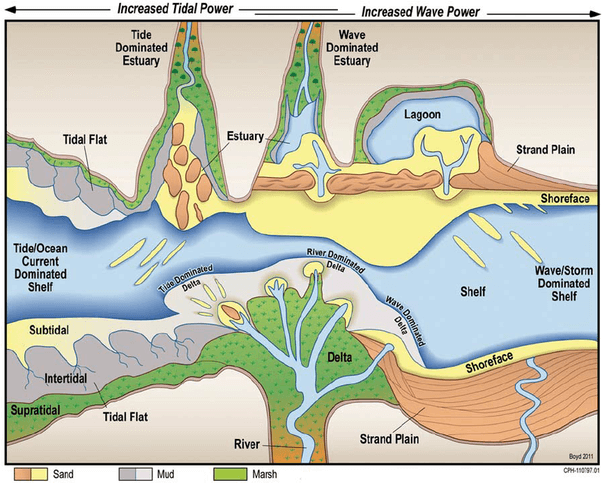
Lagoon and Estuary
An estuary refers to a coastal body of water that is partially enclosed having a river or a stream, or several of them flowing into an estuary while at the same time having a free link to the ocean or the sea.
They are generally a transition zone between the river environment and ocean environment, and therefore they experience the influence of both the river and the ocean.
On the other hand, a lagoon refers to a shallow body of water that is alienated by a reef or barrier from the larger body of water, and they are common coastal landforms in different regions around the world. There are two types of lagoons and include atoll lagoons and coastal lagoons.
An atoll lagoon is normally a circular coral reef or a string of coral islands which surround a lagoon. Atoll lagoons are always much deeper than coastal lagoons and occasionally could have depths of about 65 feet deep.
Reference: oceanservice.noaa.gov

Nice effort
thankyou sir
Superb se bhi upper
Thank You Sir
Great 👍🏻
excellent effort. use it in my geography class.